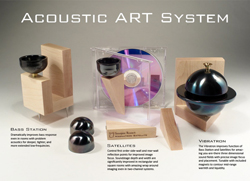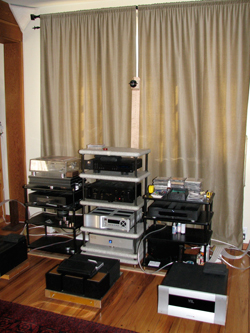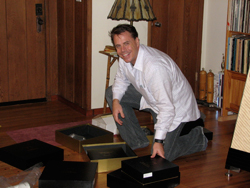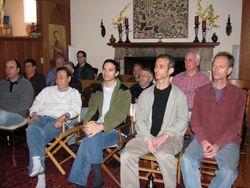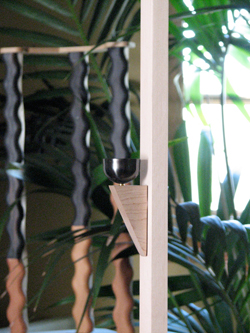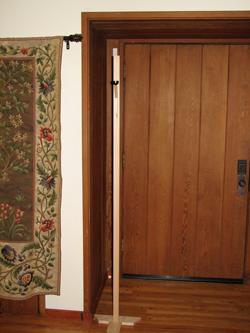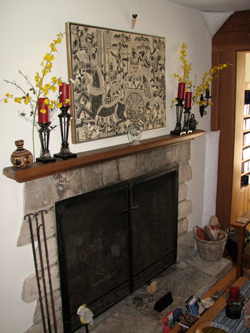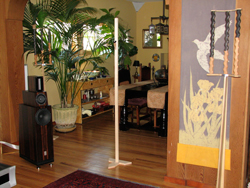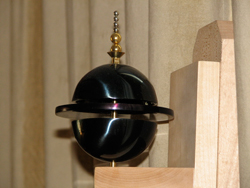Introduction
Vibratron, Gravitron, Magnetron, and Bass Station: the sci-fi names alone are enough to raise eyebrows. But when you add in the fantastic appearance of the resonating bowls, and the claims that they can tune your listening room and ameliorate most commonly encountered speaker-room interactions, it’s hard not to think that someone is either toying with you or daring you to entertain a new paradigm of acoustic science.
A Description:
Specially tuned and treated carbon steel bowls that, carefully placed in the listening room on proprietary platforms, tune music reproduction, tighten bass, adjust tonal balance, and focus sound.
Complete System (Vibratron, Bass Station, Gravitron, and two Magnetrons): $3130
Entry Level System (Gravitron + Bass Station): $1045
Synergistic Research
At the center of the Synergistic Research ACOUSTIC ART Real-Time Analogue Room Treatment – now there’s a mouthful – perches the Vibratron, a fantastically shaped blue orb that looks like a cross between the planet Saturn and a gyroscope. Complete with a set of little removable silver and gold magnets that form a spire at its apex, the Vibratron is designed to sit atop a special wooden perch that hangs from the front wall midway between and above your speakers.
Then there’s the Gravitron, a blue and purple tinted forged metal bowl that balances atop a little wooden perch. The Gravitron and its perch are designed to affix to the rear wall, close to the ceiling, directly opposite the Vibratron. On the floor below the Vibratron and (in larger rooms) the Gravitron sit one or two Bass Stations, slightly larger iron bowls that have their own spiked wooden stands that include a special “dispersion baffle.” Two other bowls called Magnetrons magnetically affix to wooden perches placed on the side walls at first reflection points.
Besides looking good enough to be on display at a Museum of Modern Art, Synergistic Research’s website claims that the ACOUSTIC ART system (heretofore referred to as “ART”) can “tune music with a system of resonators working together in harmony at key acoustic pressure points.” The magnets in the system purportedly “contour activation and decay properties of the Vibratron and Magnetron Satellite resonators.” The Vibratron is claimed to radiate “in a 360 degree pattern over a scientifically-arrived-at frequency range.” The Base Station’s dispersion baffle – a plain wooden shield that arises between it and the rest of the room – “precisely” controls how the Bass Station affects a room’s low frequency acoustics. The spikes on the Bass Station, fashionably called Stilettos, are said to mechanically couple the Bass Station to the room and further enhance control of low frequencies. Throw in the Gravitron, and you’ve got a system that operates at “mathematically-arrived-at frequencies with target decay patterns” to tune music reproduction from your audiophile or everyday sound system.
Really?
That’s the question I asked at CES 2009 in Las Vegas in January when I made the Synergistic Research room at the High Performance Audio exhibits at the Venetian Hotel my first stop. There I encountered chief designer Ted Denney, the creator of ART. The equipment in the room had not yet warmed up, the cables were not settled in, and the positioning of the ART system was hardly fine-tuned. Yet, as Ted proceeded to play music with the ART system in place, then without it, then again with ART, it was easy to hear that the system sounded considerably more focused and under control with ART.
Over the next few days of CES, John Atkinson, long-time editor of Stereophile, joined the ranks of reviewers and journalists who visited the Synergistic Research room. While John’s background as a recording engineer led him to approach the ART system with skepticism, he is also a musician with a fine ear for changes in sound. After experiencing Ted Denney’s demo, he too was convinced that the treatment made a difference.
Does it really make a difference?
As anyone familiar with my other reviews for Secrets already knows, I have no problem accepting that electrical, mechanical, or acoustic phenomena that cannot be fully explained by existing scientific methodologies may nonetheless have a profound effect on our appreciation of music. After all, music’s affects on the human psyche and spirit are not fully understood, and remain essentially mystical in nature. I don’t need to prove that something exists before I can feel and acknowledge its effects. If I’m sure I hear a difference, that’s good enough for me.
This, of course, flies in the face of so-called “objectivists” who insist that anything audible can be measured scientifically. What the “objectivists” refuse to acknowledge, however, is that so called objectivism is in fact an a priori belief system that defies the principles of science. Unless the absolute and incontrovertible answer to the question, “If a tree falls in the forest and no one is there to hear it fall, did it make a sound?” is a vehement and absolute “No!”, we must acknowledge that auditory phenomena exist independently of our ability to measure them. Why apply a different standard to all things audio, or claim that unless something can be proven conclusively by blind testing, which is at best a faulty methodology, it cannot possibly exist?
When all is said and done (as if that were ever the case), those who want to maintain the false subjectivist/objectivist dichotomy, proclaim the absolutism of blind testing, and/or dismiss ART outright are free to do so. Those who wish to explore the Synergistic Research Acoustic ART system are invited to read on, and then find a dealer who can demo the system for them.
Bringing it All Back Home
The time I spent in the Synergistic Research room was so mind-blowing that I asked Ted Denney if he would do a presentation for the Bay Area Audiophile Society (BAAS) on March 14, 2009. He agreed, as did BAAS coordinator Bob Walters.
Six weeks later, Ted flew 450 miles north from his headquarters in Southern California to install the ART system at Casa Bellecci-Serinus in Oakland. At his insistence, the installation also included a nearly full complement of Synergistic Research cabling and the SR Tesla PowerCell line conditioner. Ted returned on Friday, March 13 to fine-tune the system and make sure that everything he had installed was performing optimally.
The next morning, Denney presented two back-to-back demos for BAAS members. This review will report on those demos, and offer observations on the continued effects of ART on my enjoyment of music.
At one of the demos, Ted explained why he created ART:
“For the vast majority of real world systems, this is the only viable way to treat room acoustics. I wouldn’t want to have a bunch of monolithic absorbing tubes in my room, and a bunch of ugly panels all over the place. I like to listen to music in an aesthetically pleasing space. I don’t like my room to look like a test facility.”
Setup
Time and again you will read that a high-end system – any audio system, really – sounds best when situated in a symmetrical space that is free of bass consuming, resonant alcoves. While some audiophiles are fortunate enough to have such rooms, most of us do not. That includes yours truly.
The living / listening room at Casa Bellecci-Serinus is 24.5′ deep and 21.4′ wide. Ceilings are 9′ high with heavy wooden crossbeams, each 17” in height. The room is big enough to accommodate 16 members of the Bay Area Audiophile Society, seated in three or four rows facing the system, plus others on the periphery.
Due to room layout and the multiple uses of the living room, the system is not in the center of the room. At the far end of the room, not far from the right speaker, is a large, 8.33′ wide wooden-framed archway that leads into a large, approx. 16’x12′ dining room. The distance from the front door to the end of the dining room is 37′. This large cavity sucks up bass and plays havoc with the acoustic presentation.
There are also other openings on the right wall, close to the listening position, that lead to the 2nd floor stairway and the hallway to the kitchen. In the rear, behind the listener, is a large granite fireplace that also catches sound waves. All this messes with the sound.
There is also a lot of space to the left of the left speaker. First-order reflections aim toward a small alcove that ends at the front door. While a heavy curtain covers the windows directly behind the system, the rest of the wall behind the speakers is not flat due to record shelves and support beams.
Sensing the room’s challenges, Ted compensated for the soundstage’s natural pull to the right, caused by the large opening to the dining room, by toeing the left speaker a bit farther out. He also positioned the first-order reflection point Magnetrons on both sides of the sound system to prevent sound from resonating in alcoves. Because my room lacks solid walls on which to affix the Vibratron and first-order reflection Magnetrons, their bases were hung from special stands that Ted constructed in his factory.
Ted also brought two Bass Stations, placing one beneath the Vibratron (its traditional position) and another beneath the Gravitron. While most rooms do not need two Bass Stations, the extra bass resonance of my fireplace, and the size of the space, mandated the second one. (Ted explains this below).
Cabling and Power Treatment
Whenever I review equipment, I strive to keep the rest of my reference system constant; this enables me to best ascertain how the equipment under review is affecting the sound of the system. Ted, as noted above, wanted to demonstrate his Synergistic Research Tesla PowerCell and cabling in addition to the ART system. Hence, my Nordost Thor and most if not all of my reference Nordost Odin cabling, save for the speaker cables, was replaced. Since most of the Synergistic cabling has active shielding which requires it to be plugged in, Ted brought one of his long power strips especially for that purpose.
The change of so much at once skewed my reference. Hence, I spent some time getting used to the sonic changes before Ted did his final set-up and conducted the demo.
To these ears, unless it is fundamentally incompatible with Nordost, the Synergistic cabling is noticeably darker than Nordost Odin. Ted told me that, had I allowed his cabling two months to settle in, his cables would have fully opened up and displayed a lot more top end. That, however, was not possible in a reference system that needs consistency of sound for music and equipment review purposes.
Hence, I shall not attempt a review of either the Synergistic Cabling or the Tesla PowerCell (which has a special connector that only accommodates a specially-terminated Synergistic Research power cable). Nonetheless, as you’ll read below, the barely settled in Synergistic cabling did an astounding job controlling bass and creating a three-dimensional soundstage.
Shakti Hallographs
At the time Ted arrived to set up my room, I was already using five of Frank Cheng’s Acoustic Resonators, four Shakti Hallographs, and a number of padded room tuning accoutrements (Room Tunes, Echo Busters, etc.) to help control errant reflections and focus sound. For the demo, the Acoustic Resonators were of course removed, so that we could focus on the effects of Ted’s competing system. The Shakti Hallographs, which Ted likes, remained along with the other room treatment.
Ted and I experimented with the placement and setting of the mid-room Hallographs, as well as the two behind the speakers. Once Ted and his cables departed, and I returned to using Nordost cabling, I made further modifications to Hallograph position and settings.
Ted likes the hallographs and is quite familiar with them. “They work really well with my products and Frank’s,” he says. “The do the same thing, but at a much lower frequency. And they’re directional, while my bowls are omni-directional.”
History of ART
During the BAAS demos, Ted offered two complete and complementary explanations of the ART system. The following material, quoted verbatim from his talks, combines information shared in those demos.
“In 2003, when I had no inspiration for audio or anything else anymore, and got completely burned out, I sold my house, an appreciating asset, to buy a sailboat, a depreciating asset. I then spent three years sailing single-handedly around the Pacific. I sailed from Alameda to Hawaii, then worked my way to Tahiti and beyond. I was going to go around the world, but ran out of time.
One of the things I did as I went along was visit Buddhist temples. Some of them had Tibetan prayer bowls in them. Whenever they would activate the bowls while I was sitting in the temples, I noticed a distinct shift in room acoustics. That led me to think, ‘If this is the case, I’ll bet you could engineer some bowls in a system, setting them up around the room at key pressure points to effectively treat room acoustics.’
Then I didn’t think too much more about it. When I returned from sailing and developed my current line of Tesla series cables, I learned that there was a gentleman named Frank Cheng in France who was making a series of resonator. Frank was using precious metals to forge small little bowls. Thinking, ‘Okay, somebody’ already doing that,’ I bought into the system, and invested $20,000 retail in his products.
There were things I liked about his system, and things I didn’t like. I felt that using precious metals created a significant increase in the cost, and an added layer of complexity. I thought I could come up something better that was a lot more powerful, and that cost a lot less money because it wasn’t made out of precious metals.
Technical Explanation
I developed a resonator system based on specially tuned and treated carbon steel. The bowls are forged, not cast, from carbon steel plates. This process, which bends the crystal structure into the shape of the resonator bowl, creates a lot of heat. We experimented with three different ways to shape them, including casting and shaping them with a Swish screw machine. Forging was the best, because it lends the steel sonic qualities we can’t get through the other two processes. But it also has an extremely high waste.
After that, we put the bowl on a little stand, and tap it with a steel hammer so that they ring. We mike it, record the sound, and use a spectrum analyzer to take a look at its decay and spectral properties. The amount of labor it takes to produce one bowl is far more than you realize because of this process. 90% of all bowls are destroyed because they don’t have the right acoustic properties.
After a bowl passes the test, I heat treat each one with a flame to polish them. That’s what creates their unique color – they’re actually silver to start with. While they’re being heat-treated, someone again taps them with a hammer so we can look at its decay properties as the sound and resonant properties change with case hardening. When the bowl has the right sonic characteristics, it heads into an oil bath to stop the case hardening process. One of out of three at that point doesn’t reach proper characteristics, and are then recycled.
Next, the good bowls are sent to a climate-controlled, dust-free clean room where they’re sprayed with a German violin lacquer. This keeps them from rusting and also affects their acoustic properties and their ability to control the sound in your listening room. I experimented extensively to find a lacquer that has no detrimental effect on resonance.
Finally, the bowls are quantum-tunneled with 2,000,000 volts from a Tesla coil. Quantum tunneling is a large, purpose-built solid-state Tesla coil that throws a 5-foot arc into a tray of resonators, hits one, bounces between them in an arc, and passes through all of them. For some reason, this has an affect on their acoustic properties. We came across this empirically.
We also quantum tunnel instruments for musicians in Hollywood. They bring us their French horns and trumpets, and we quantum tunnel them to open them up significantly and get rid of congested sound. I’m even going to treat some concert pianos by bringing the coil on location and taking a day or two to treat the metal strings and internal metal with 2,000,000 volts.
There was a lot of subtle detail involved in creating the ART system. We listened to dozens of different types of wood to determine which sounds best. The supports that separate the two resonating bowls in the Vibratron (gong) are a type of marine brass. The gold and silver magnets atop it – everything plays a part in the final product. The bowls are like a fine musical instrument that has been tuned to perfection. Everything is based on the principals of harmonics.
The Bass Station
The satellite at the back of the room near the top of the wall is held in place by gravity, so I call it a Gravitron.
The Bass Station resonator is on a special stand that is spiked. I found that when you spike the stand, it had the exact same effect as when you spike a pair of speakers, namely, a tighter bottom end, and a more layered and delineated sound field behind the speakers. When you don’t spike the bass station, the sound is a bit woollier, and the soundfield is pushed forward.
The stand also has a phase baffle – it blocks your view of the resonator – which prevents the Bass resonator from affecting the room as a whole, and maintains its control of the low frequency standing wave, which is primarily behind your speakers for the low frequencies.
Even in a small room with monitors that don’t produce deep bass, you need the Bass Station because you’re generating standing waves at your low frequencies that are having a negative effect on your midrange and highs. I’ve treated rooms that were 10 x 10. When I set up the complete ART system, I created an expansive soundfield as if it was a bigger room, with layering way outside the boundaries of the listening room, wrapping around, creating a sense of hall that was significantly larger than the little 10 x 10 cubicle.
If you have a difficult room such as Jason’s, with this huge bass cavity of a fireplace that is a bozo no-no for low frequencies, you can add a second base station at the back wall. The only time other than this that I’ve needed two bass stations was in that 10 x 10 room. It sounded like the guy had a subwoofer going into sub-harmonics. The second bass station elongated the room acoustically, tightened things up, and enabled you to hear what was actually going on.
How do you position the units?
The Vibratron [the blue orb that looks a bit like Saturn and its moons] is placed equidistant from your speakers on the wall behind your speakers, four to five feet above the ground. Changing the height affects the timbre. In this room, we decided to place it a little bit higher than usual. We’ve just started to sell the stand that it’s on.
Below the Vibratron goes the primary Bass station. Because we also have this huge bass cavity in Jason’s fireplace behind the listening position, we’ve placed a second Bass Station.
On the back wall, opposite the Vibratron, we’ve got a Gravitron satellite. It is not magnetically coupled because that works best. (It and the Bass Station are held in place by gravity; the Magnetron side satellites are held in place by magnets).
At your primary seating position, you have someone move a mirror across the sidewall and look for the reflection of the tweeter in the mirror. You can also use a laser pointer. When the laser reflects in the mirror and hits your tweeter, that’s your first reflection point.
You put a Magnetron satellite at the left and right points. If you want to make the sound smoother and more diffuse, you move them a few inches toward the listening position. You also experiment with the height; normally you want them higher than ear level. They don’t normally come with stands, but Jason’s is a very challenging room to treat, and I’m happy it’s working as well as it is.
In this room, we’ve placed the side satellites at first reflection points to create a false wall, and stop sound from resonating in the front door alcove and dining room. If you want to make the sound smoother and more diffuse, move them a few inches toward the listening position.
Magnets and Magnetism
I use magnets to contour and control the activation and decay properties on the side resonators at first reflection points. I also use stackable magnets on the Vibratron to tune its characteristics and get the type of midrange you want in the room. Magnetism is not desirable on the aft resonator up high or the bass resonator. If you use a magnet on the bass station, it will destroy its effects.
The more removable magnets you put on the Vibratron, the sweeter the midrange and richer and sweeter top end. Removing magnets shifts the timbre more into the treble. The gold magnets are stronger, and affect the midrange; the smaller silver ones increase the sweetness of the highs. Essentially they increase the dampening of the Vibratron. The activation of the Vibratron in turn affects the function of the other satellites in the room.
Options and Prices
If you want to save some money, you can use a Gravitron satellite in place of the Vibratron. A minimal Acoustic ART setup, which costs under $1100, consists of the Gravitron satellite ($295) and a single BAAS Station ($750). By itself, it should make a dramatic improvement over an untreated room. An additional Vibratron, which not only reacts in real time to the music, but also affects all the other satellites, costs $1495. Two additional Magnetron side satellites cost $295 each. Even with the full monty which is a little over $3000 – typically, two bass stations don’t sound as good as one –that’s extremely affordable for treating a room. You easily could put another zero behind that figure with Rives Audio and not necessarily get better results.”
The Sound
When Ted and I looked for good non-classical tracks to use in the demo, we settled upon Patricia Barber’s “Silent Partner” from the Mobile Fidelity SACD/DSD reissue of Modern Cool. Something about the sparse musical arrangement and array of percussion made for revelations on my reference system.
First Ted played the music with the entire ART system in place. Then he simply removed the two Magnetron satellites. Virtually everyone in the room noticed the loss of focus and clarity. We experienced an even greater difference when Ted first removed the entire ART system, then put it back in place. (Note: If you turn a resonator bowl over, so that the opening faces downward on a hard surface, it no longer affects the sound in the room).
Additional changes in sound were noted when the small magnets that perch atop the Vibratron were removed, and then slowly replaced, one-by-one. After experiencing the full transition, one attendee noted, “When you were taking the magnets on and off the Vibratron, it affected the midrange so dramatically. Yet I found that with the magnets off, for me it was a little less veiled in the midrange.”
Ted replied, “It’s not a question of veiling; it’s a question of tonal balance. You’ll actually find through long-term listening that you’re not losing any information with more magnets; it’s about balance. The experience is kind of like when you change the setting on your plasma TV, and you can’t decide which is more real.”
Ted next removed some of the magnets from the Vibratron and played the first five or six minutes of the Royal Concertgebouw Orchestra’s spectacular SACD of Richard Strauss’ Alpine Symphony. Strauss calls for a huge orchestra, wind machine, cowbells, you name it. The opening is an extreme test for woofers.
After listening, another attendee commented, “Here’s a very crude analogy. If you have a boom box with a lot of listening options, you can add ambience, which takes it out of phase. Some people like the change, but I think it cheapens the sound. Here, you get more ambience, but there’s no cheapening effect. Adding more magnets makes the music come alive. This was most apparent in this recording of Strauss. There may have been more intimacy before, but the added magnets really made it come alive.”
Ted then further clarified the issue. “Sometimes, when information is removed, music seems sharper in focus because there’s less information to process. Eventually one learns to process all the additional information that you can hear clearly as a result of ART.” Ted even claimed that, on highly resolving systems, you can actually hear miking patterns on recordings with ART in place.
Throughout both demos, which included a few tracks that attendees had brought along, I kept noticing how much more bass control, midrange clarity, and acuteness of focus I was experiencing with ART. After Ted left and I restored my entire reference system, I became firmly convinced of the huge difference that ART makes. All I had to do was remove the two first reflection point Magnetrons to discover how much newfound clarity of image, tonal definition, and three-dimensionality I lost without them.
My only criticism of the sound of the ART system is that, with my Nordost cabling back in the system, and the Magnetrons exactly positioned at first reflection points, the system sometimes sounded too bright and piercing. Moving the Magnetrons a few inches from their optimal positions totally rectified the situation.
System Comparison
It was not possible for me to directly compare the Synergistic Research ART system with Frank Cheng’s Acoustic Resonators. While ART comes in just a few configurations, mine being the maximum, Cheng sells a host of resonators at widely different price points. At home, I only have five of the lower priced Acoustic Resonators; they do not give a complete picture of what a system tuned with more resonators, including the far more expensive silver, gold and platinum varieties, can sound like.
What I can say with certainty is that a full ART system, even with a second Bass Station, costs far, far less than a complete Acoustic Resonator set-up that uses the higher priced resonators. ART resonators are far easier to position correctly and maintain in place than the Acoustic Resonators. Cheng’s little pointed bowls are hard to get just right. Sometimes just when you’re trying to tap the resonator slightly to get it at the angle you want, it falls off its perch, and you need to start all over again. In addition, in my house, at least one of my resonators has been known to fall off its perch when the front door is slammed shut.
Conclusions
I cannot imagine living without my Synergistic Research ACOUSTIC ART Real-Time Analogue Room Treatment. From tightening and controlling previously errant bass and allowing far more information to come through to increasing image depth and focusing individual elements within a larger, more expansive soundstage, ART makes a major impact on the enjoyment of music. There is simply more there there with ART in place. I expect you could obtain at least some of ART’s benefits by adding a sophisticated DSP device to your component chain, but that would call for another shelf on the rack, another set of interconnects, and another power cable. It might also add another level of electronic haze to the proceedings. ART tunes your system and room without in any way veiling sound or obscuring detail.



